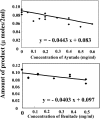Immune effects and antiacetylcholinesterase activity of Polygonum hydropiper L
- PMID: 27200260
- PMCID: PMC4858880
- DOI: 10.12938/bmfh.2015-016
Immune effects and antiacetylcholinesterase activity of Polygonum hydropiper L
Abstract
To determine the potential utility of Polygonum hydropiper (tade) as an anti-dementia functional food, the present study assessed the acetylcholinesterase inhibitory and anti-inflammatory activities of tade crude extracts in human cells. Crude extracts of tade were obtained by homogenizing tade in distilled water and then heating the resulting crude extracts. The hot aqueous extracts were purified by centrifugation and freeze-dried. The inhibition of acetylcholinesterase (AChE) by tade was investigated quantitatively by Ellman's method. Furthermore, the in vitro effects on human leukocytes (phagocytic activity, phagosome-lysosome fusion, and superoxide anion release) of coating inactive Staphylococcus aureus cells with tade crude extracts were studied. The tade crude extracts inhibited AChE activity. Furthermore, they increased phagocytic activity and phagosome-lysosome fusion in human neutrophils and monocytes in a nominally dose-dependent manner. However, the tade crude extracts did not alter superoxide anion release (O2 (-)) from neutrophils. Our results confirmed that crude extracts of P. hydropiper exhibit antiacetylcholinesterase and immunostimulation activities in vitro. P. hydropiper thus is a candidate functional food for the prevention of dementia.
Keywords: Polygonum hydropiper; anti-acetylcholinesterase; functional food; phagocytosis; phagosome-lysosome fusion; superoxide anion release.
Figures





Similar articles
-
Evaluation of Alpha-Amylase Inhibitory, Antioxidant, and Antimicrobial Potential and Phytochemical Contents of Polygonum hydropiper L.Plants (Basel). 2020 Jul 6;9(7):852. doi: 10.3390/plants9070852. Plants (Basel). 2020. PMID: 32640649 Free PMC article.
-
Effects on immune response of antidiabetic ingredients from white-skinned sweet potato (Ipomoea batatas L.).Nutrition. 2005 Mar;21(3):358-62. doi: 10.1016/j.nut.2004.11.001. Nutrition. 2005. PMID: 15797679
-
Comparative chemical profiling, cholinesterase inhibitions and anti-radicals properties of essential oils from Polygonum hydropiper L: a preliminary anti- Alzheimer's study.Lipids Health Dis. 2015 Nov 4;14:141. doi: 10.1186/s12944-015-0145-8. Lipids Health Dis. 2015. PMID: 26530857 Free PMC article.
-
Stimulatory effect of gangliosides on phagocytosis, phagosome-lysosome fusion, and intracellular signal transduction system by human polymorphonuclear leukocytes.Glycoconj J. 1997 Sep;14(6):707-14. doi: 10.1023/a:1018517400380. Glycoconj J. 1997. PMID: 9337083
-
Stimulation of phagocytosis and phagosome-lysosome fusion by glycosphingolipids from Sphingomonas paucimobilis.J Biochem. 1995 Aug;118(2):271-7. doi: 10.1093/oxfordjournals.jbchem.a124902. J Biochem. 1995. PMID: 8543558
Cited by
-
Therapeutic potential of aromatic plant extracts in Alzheimer's disease: Comprehensive review of their underlying mechanisms.CNS Neurosci Ther. 2023 Aug;29(8):2045-2059. doi: 10.1111/cns.14234. Epub 2023 Apr 30. CNS Neurosci Ther. 2023. PMID: 37122144 Free PMC article. Review.
-
Chromatographic Analysis and Enzyme Inhibition Potential of Reynoutria japonica Houtt.: Computational Docking, ADME, Pharmacokinetic, and Toxicokinetic Analyses of the Major Compounds.Pharmaceuticals (Basel). 2025 Mar 14;18(3):408. doi: 10.3390/ph18030408. Pharmaceuticals (Basel). 2025. PMID: 40143185 Free PMC article.
-
Traditional Herbal Medicines Against CNS Disorders from Bangladesh.Nat Prod Bioprospect. 2020 Dec;10(6):377-410. doi: 10.1007/s13659-020-00269-7. Epub 2020 Oct 14. Nat Prod Bioprospect. 2020. PMID: 33057963 Free PMC article. Review.
References
-
- Population Division of the Department of Economic and Social Affairs of the United Nations Secretariat. 2013. World Population Prospects: The 2012 Revision: 31 New York. http://esa.un.org/wpp/documentation/pdf/wpp2012_highlights.pdf (accessed 2015-07-11)
-
- American Psychiatric Association. 2013. Diagnostic and Statistical Manual of Mental Disorders, Fifth edition-5 (DSM-5), Nurocognitive disorders 591–644. http://www.terapiacognitiva.eu/dwl/dsm5/DSM-5.pdf (accessed 2015-07-29)
-
- Cutler NR, Sramek JJ. 1998. The role of bridging studies in the development of cholinesterase inhibitors for Alzheimer’s disease. CNS Drugs 10: 355–364.
LinkOut - more resources
Full Text Sources
Other Literature Sources
